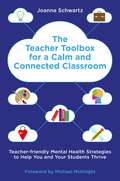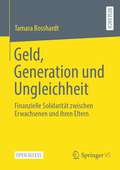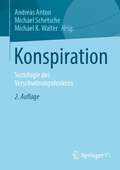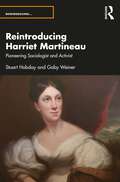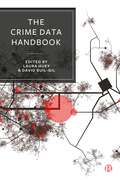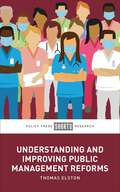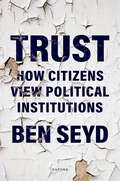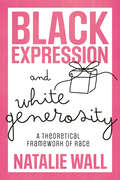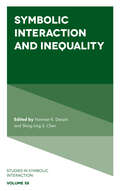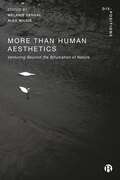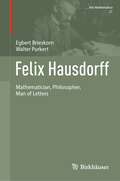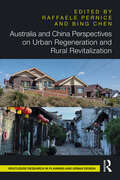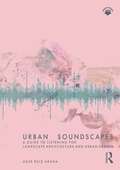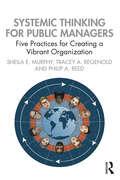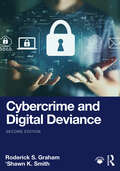- Table View
- List View
The Teacher Toolbox for a Calm and Connected Classroom: Teacher-Friendly Mental Health Strategies to Help You and Your Students Thrive
by Joanna SchwartzThe Teacher Toolbox for a Calm and Connected Classroom is a whole-child, whole-hearted approach to teaching, wellness, and student--teacher relationships.Chock-full of practical advice and brain-based tools from an experienced teacher and counselor, this book solves the question of how psychology and education can enrich and empower both teachers and students' wellness. Peppered with relatable anecdotes from the authors' experiences, the book deals with how to help unpack the' "invisible backpack" that both teachers and students bring into the classroom. Chapters are broken down to show how to practically address common issues such challenging behavior, social-emotional learning, trauma-informed education, attachment theory, mindfulness, mental health and much more. Each chapter outlines these common challenges but also provides an abundance of practical tools that can be used to help. Written accessibly, and with tools which are easy to implement, The Teacher Toolbox for a Calm and Connected Classroom is an indispensable guide for any teacher.
Geld, Generation und Ungleichheit: Finanzielle Solidarität zwischen Erwachsenen und ihren Eltern
by Tamara BosshardtDas vorliegende Open-Access-Buch analysiert finanzielle Transfers zwischen Erwachsenen und ihren Eltern, die zur Reproduktion von Ungleichheiten auf der Makroebene beitragen. Soziale Ungleichheiten in der Kindergeneration lassen sich zu einem grossen Teil auf soziale Ungleichheiten in der Elterngeneration zurückführen. Genauer geht die Autorin den Fragen nach, wer mehr bzw. weniger Geld-, Sachgeschenke oder Zahlungen leistet und erhält, welche Faktoren Unterschiede im Transferverhalten erklären und wie sich finanzielle Transfers zwischen Generationen auf Ungleichheitsstrukturen in der Kindergeneration auswirken. Die theoretische Perspektive kombiniert Ansätze aus der Ungleichheits- und Familiensoziologie mit Theorien zur Erklärung von solidarischem Handeln und kumulativen Prozessen. Ob und in welchem Umfang sich Erwachsene und ihre Eltern gegenseitig unterstützen können, hängt stark von ihren jeweiligen ökonomischen Ressourcen ab. Auf gesellschaftlicher Ebene bedeutet lebenslange familiale Solidarität daher häufig lebenslange Ungleichheit von Unterstützungsstrukturen. Finanzielle Transfers zwischen Familiengenerationen reduzieren damit zwar Ungleichheiten innerhalb von Familien, tragen insgesamt aber zu einer Verschärfung der Ungleichheiten zwischen Familien bei.
Konspiration: Soziologie des Verschwörungsdenkens
by Andreas Anton Michael Schetsche Michael K. WalterSpätestens seit der Corona-Pandemie werden Verschwörungstheorien zunehmend als gesellschaftspolitisches Problem wahrgenommen und sind zum Politikum geworden. Wohl noch nie zuvor gab es im öffentlichen Diskurs eine derart hohe Sensibilität für das Thema. Ängste vor Verschwörungen einerseits und Ängste vor Verschwörungstheorien andererseits schaukeln sich offenbar gegenseitig hoch. Dies führt zu einer anwachsenden gesellschaftlichen Polarisierung und zu einem Klima von Misstrauen, Empörung und Gereiztheit. Zehn Jahre nach der Erstauflage des vorliegenden Bandes erscheint die Analyse des gegenwärtigen Verschwörungsdenkens dringender denn je. Im Rahmen von sechs neuen Beiträgen nimmt die erweiterte Neuauflage aktuelle Entwicklungen in den Blick. In Kombination mit den ursprünglichen Aufsätzen soll so zu einem umfassenden und differenzierten Bild des sozialen Phänomens Verschwörungstheorien beigetragen werden.
Reintroducing Harriet Martineau: Pioneering Sociologist and Activist (Reintroducing...)
by Stuart Hobday Gaby WeinerThis book explores the innovative, sociological approach adopted by Harriet Martineau in her efforts to develop a ‘scientific’ approach to understanding social and societal change. With attention to her focus on the key social structures and societal issues of her day – the economy, education, the condition of women and the evils of slavery – the authors highlight her creation and application of what we now recognise as sociological methodology, fieldwork and analysis. Through an examination in each chapter of the writings that best illustrate Martineau’s sociological perspective, Reintroducing Harriet Martineau discusses her enduring contribution to sociology. As such, it will appeal to scholars and students of sociology with interests in the history of the discipline and questions of methodology.
Reintroducing Harriet Martineau: Pioneering Sociologist and Activist (Reintroducing...)
by Stuart Hobday Gaby WeinerThis book explores the innovative, sociological approach adopted by Harriet Martineau in her efforts to develop a ‘scientific’ approach to understanding social and societal change. With attention to her focus on the key social structures and societal issues of her day – the economy, education, the condition of women and the evils of slavery – the authors highlight her creation and application of what we now recognise as sociological methodology, fieldwork and analysis. Through an examination in each chapter of the writings that best illustrate Martineau’s sociological perspective, Reintroducing Harriet Martineau discusses her enduring contribution to sociology. As such, it will appeal to scholars and students of sociology with interests in the history of the discipline and questions of methodology.
The Crime Data Handbook
by Ian Brunton-Smith Tim Verlaan Henk Elffers Sam Langton Stuart Thomas Sophie Curtis-Ham Sarah Czarnomski Lisa Tompson Jesús C. Aguerri Fernando Miró-Llinares Kirsty Bennett Tomas Diviak Craig Bennell Tori Semple Bryce Jenkins Jack Cunliffe Angelo Moretti Jose Pina-Sanchez Thiago R. Oliveira Leticia Couto Marta Murrià Sangenís Cristina Sobrino Garcés Timothy I. Cubitt Mark Mills Nico Trajtenberg Olga Sanchez de Ribera de Castro Carly Lighttowlers Lucy Bryant Olivia Horsefield Francisco J. Castro-Toledo Ana B. Gómez-Bellvís Scott Keay Jude Towers Sara Correia-Hopkins José María López Riba Raquel Bartolomé Gutiérrez Esther Fernández-Molina Rosemary Barberet Anthony Morgan Alexandru Cernat Alex Sutherland Nicholas LordCrime research has grown substantially over the past decade, with a rise in evidence-informed approaches to criminal justice, statistics-driven decision-making and predictive analytics. The fuel that has driven this growth is data – and one of its most pressing challenges is the lack of research on the use and interpretation of data sources. This accessible, engaging book closes that gap for researchers, practitioners and students. International researchers and crime analysts discuss the strengths, perils and opportunities of the data sources and tools now available and their best use in informing sound public policy and criminal justice practice.
The Crime Data Handbook
by Ian Brunton-Smith Tim Verlaan Henk Elffers Sam Langton Stuart Thomas Sophie Curtis-Ham Sarah Czarnomski Lisa Tompson Jesús C. Aguerri Fernando Miró-Llinares Kirsty Bennett Tomas Diviak Craig Bennell Tori Semple Bryce Jenkins Jack Cunliffe Angelo Moretti Jose Pina-Sanchez Thiago R. Oliveira Leticia Couto Marta Murrià Sangenís Cristina Sobrino Garcés Timothy I. Cubitt Mark Mills Nico Trajtenberg Olga Sanchez de Ribera de Castro Carly Lighttowlers Lucy Bryant Olivia Horsefield Francisco J. Castro-Toledo Ana B. Gómez-Bellvís Scott Keay Jude Towers Sara Correia-Hopkins José María López Riba Raquel Bartolomé Gutiérrez Esther Fernández-Molina Rosemary Barberet Anthony Morgan Alexandru Cernat Alex Sutherland Nicholas LordCrime research has grown substantially over the past decade, with a rise in evidence-informed approaches to criminal justice, statistics-driven decision-making and predictive analytics. The fuel that has driven this growth is data – and one of its most pressing challenges is the lack of research on the use and interpretation of data sources. This accessible, engaging book closes that gap for researchers, practitioners and students. International researchers and crime analysts discuss the strengths, perils and opportunities of the data sources and tools now available and their best use in informing sound public policy and criminal justice practice.
Understanding and Improving Public Management Reforms
by Thomas ElstonWhy do top-down reforms to public services so often over-promise and under-deliver? Using five concepts from psychology, economics and organisational sociology, Thomas Elston addresses this pressing question of good governance. Rather than focusing on the challenge of implementation, Understanding and Improving Public Management Reforms reveals how flawed policy design is often the major contributor to reform failure. Cognitive bias, restrictive social institutions and inattention to ‘quiet costs’ during the policy-making process are essential to explaining the poor track record of reforms to date – and point the way towards better decision-making in future. Written for policy professionals, service managers, students and researchers alike, this concise, practical and multidisciplinary study draws on varied examples to help reconceive the perennial problem of public management reform – and to propose new solutions.
Trust: How Citizens View Political Institutions
by Dr Ben SeydWe seem to be living in an age of citizen distrust of social and political elites. Distrust is also seen to have numerous negative consequences for our civic and democratic life. Yet are western democracies really facing a crisis of trust? This book provides an extensive and up-to-date review of one of the most important topics in contemporary political life. It explores the nature and condition of trust today by exploring three key issues. What do we mean by trust? How far are levels of trust in decline? How damaging are the consequences of low trust for effective democratic governance? Seyd also considers how trust arises, and which factors might explain the declines in trust witnessed recently in many countries. Providing evidence from many countries, Trust: How Citizens View Political Institutions pays particular attention to Britain, which has seen a marked decline in public regard for political elites, making the country a vital case for identifying the causes and effects of low trust. Combining conceptual and empirical analysis, the book provides a timely analysis of a central issue in contemporary political debate.
Trust: How Citizens View Political Institutions
by Dr Ben SeydWe seem to be living in an age of citizen distrust of social and political elites. Distrust is also seen to have numerous negative consequences for our civic and democratic life. Yet are western democracies really facing a crisis of trust? This book provides an extensive and up-to-date review of one of the most important topics in contemporary political life. It explores the nature and condition of trust today by exploring three key issues. What do we mean by trust? How far are levels of trust in decline? How damaging are the consequences of low trust for effective democratic governance? Seyd also considers how trust arises, and which factors might explain the declines in trust witnessed recently in many countries. Providing evidence from many countries, Trust: How Citizens View Political Institutions pays particular attention to Britain, which has seen a marked decline in public regard for political elites, making the country a vital case for identifying the causes and effects of low trust. Combining conceptual and empirical analysis, the book provides a timely analysis of a central issue in contemporary political debate.
Black Expression and White Generosity: A Theoretical Framework of Race
by Natalie Wall“Ungrateful.” An accusation that will be instantly familiar to non-white people throughout majority-white states, levelled by everyone from online trolls to government ministers. Despite a centuries-old colonial history of exploitation, displacement, and enslavement, whiteness continues to construct itself as generous and benevolent: the brave liberators of slaves rather than their captors; the recipients of immigrants to their great lands rather than perpetrators of racist hate crimes; the protectors of the marginalised rather than the perpetrators of oppression. In Black Expression and White Generosity: A Theoretical Framework of Race, Natalie Wall takes readers on a journey through the tropes and narratives of white generosity, from the onset of the African slave trade to contemporary efforts to ridicule and undermine the “woke agenda.” She offers a theoretical framework for use by antiracist scholars, students, and activists to name and interrogate this pervasive attitude and its role in the structures of white supremacy and in the continued marginalisation of non-white people. Providing an exploration of lived experience and of the theoretical underpinnings of that lived experience, Wall offers a new vocabulary with which to speak truth to power and decentre whiteness from the work of antiracism, by looking to moments of black expression and creativity in black arts production. Taking inspiration from the bold, powerful, and experimental work of black artists and activists, Black Expression and White Generosity forges an alternative narrative that strives for freedom and justice without relinquishing anything in return. It is your indispensable guide to remaining ungrateful.
Black Expression and White Generosity: A Theoretical Framework of Race
by Natalie Wall“Ungrateful.” An accusation that will be instantly familiar to non-white people throughout majority-white states, levelled by everyone from online trolls to government ministers. Despite a centuries-old colonial history of exploitation, displacement, and enslavement, whiteness continues to construct itself as generous and benevolent: the brave liberators of slaves rather than their captors; the recipients of immigrants to their great lands rather than perpetrators of racist hate crimes; the protectors of the marginalised rather than the perpetrators of oppression. In Black Expression and White Generosity: A Theoretical Framework of Race, Natalie Wall takes readers on a journey through the tropes and narratives of white generosity, from the onset of the African slave trade to contemporary efforts to ridicule and undermine the “woke agenda.” She offers a theoretical framework for use by antiracist scholars, students, and activists to name and interrogate this pervasive attitude and its role in the structures of white supremacy and in the continued marginalisation of non-white people. Providing an exploration of lived experience and of the theoretical underpinnings of that lived experience, Wall offers a new vocabulary with which to speak truth to power and decentre whiteness from the work of antiracism, by looking to moments of black expression and creativity in black arts production. Taking inspiration from the bold, powerful, and experimental work of black artists and activists, Black Expression and White Generosity forges an alternative narrative that strives for freedom and justice without relinquishing anything in return. It is your indispensable guide to remaining ungrateful.
Symbolic Interaction and Inequality (Studies in Symbolic Interaction #58)
by Shing-Ling S. ChenActing as a follow up to Volume 41 of Studies in Symbolic Interaction (2013), Symbolic Interaction and Inequality explores further the concept of Radical Interactionism, a perspective of researching domination and subordination introduced by scholar Lonnie Athens. Demonstrating advancements made in Radical Interactionism over the past decade, chapters examine the omnipresent and insidious nature of inequality as well as its social construction among family members, cisgender and gender-diverse people, as well as university students and personnel, particularly college athletes. Highlighting fruitful accomplishments achieved by a range of symbolic interactionists, this volume exhibits the significance of studying inequality, a venture that not only enriches symbolic interactionism but human life as a whole.
Symbolic Interaction and Inequality (Studies in Symbolic Interaction #58)
by NORMAN K. DENZIN AND SHING-LING S. CHENActing as a follow up to Volume 41 of Studies in Symbolic Interaction (2013), Symbolic Interaction and Inequality explores further the concept of Radical Interactionism, a perspective of researching domination and subordination introduced by scholar Lonnie Athens. Demonstrating advancements made in Radical Interactionism over the past decade, chapters examine the omnipresent and insidious nature of inequality as well as its social construction among family members, cisgender and gender-diverse people, as well as university students and personnel, particularly college athletes. Highlighting fruitful accomplishments achieved by a range of symbolic interactionists, this volume exhibits the significance of studying inequality, a venture that not only enriches symbolic interactionism but human life as a whole.
More-Than-Human Aesthetics: Venturing Beyond the Bifurcation of Nature (Dis-positions: Troubling Methods and Theory in STS)
by Mike Michael Michael Halewood Thomas P. Keating Alexander Damianos Michael L. Thomas Martin Savransky Cecile Malaspina Maximilian Haas Matthew Fuller Andy Goffey Didier Debaise Nicholas GaskillDrawing on the philosophies of Alfred North Whitehead and Félix Guattari, this book develops aesthetics as central to all more-than-human forms of experience, including knowledge practices. Each contribution invites readers on an adventure to explore how this broader view of aesthetics can reshape areas including biomedicine, geological forensics, nuclear waste, race, as well as arts and education. This is an agenda-setting contribution to understanding the significance of aesthetics in science and technology studies, as well social and cultural research more broadly.
Understanding and Improving Public Management Reforms
by Thomas ElstonWhy do top-down reforms to public services so often over-promise and under-deliver? Using five concepts from psychology, economics and organisational sociology, Thomas Elston addresses this pressing question of good governance. Rather than focusing on the challenge of implementation, Understanding and Improving Public Management Reforms reveals how flawed policy design is often the major contributor to reform failure. Cognitive bias, restrictive social institutions and inattention to ‘quiet costs’ during the policy-making process are essential to explaining the poor track record of reforms to date – and point the way towards better decision-making in future. Written for policy professionals, service managers, students and researchers alike, this concise, practical and multidisciplinary study draws on varied examples to help reconceive the perennial problem of public management reform – and to propose new solutions.
More-Than-Human Aesthetics: Venturing Beyond the Bifurcation of Nature (Dis-positions: Troubling Methods and Theory in STS)
by Mike Michael Michael Halewood Thomas P. Keating Alexander Damianos Michael L. Thomas Martin Savransky Cecile Malaspina Maximilian Haas Matthew Fuller Andy Goffey Didier Debaise Nicholas GaskillDrawing on the philosophies of Alfred North Whitehead and Félix Guattari, this book develops aesthetics as central to all more-than-human forms of experience, including knowledge practices. Each contribution invites readers on an adventure to explore how this broader view of aesthetics can reshape areas including biomedicine, geological forensics, nuclear waste, race, as well as arts and education. This is an agenda-setting contribution to understanding the significance of aesthetics in science and technology studies, as well social and cultural research more broadly.
Felix Hausdorff: Mathematician, Philosopher, Man of Letters (Vita Mathematica #21)
by Egbert Brieskorn Walter PurkertFelix Hausdorff is a singular phenomenon in the history of science. As a mathematician, he played a major role in shaping the development of modern mathematics in the 20th century. He founded general topology as an independent mathematical discipline, while enriching set theory with a number of fundamental concepts and results. His general approach to measure and dimension led to profound developments in numerous mathematical disciplines, and today Hausdorff dimension plays a central role in fractal theory with its many fascinating applications by means of computer graphics. Hausdorff ’s remarkable mathematical versatility is reflected in his published work: today, no fewer than thirteen concepts, theorems and procedures carry his name. Yet he was not only a creative mathematician – Hausdorff was also an original philosophical thinker, a poet, essayist and man of letters. Under the pseudonym Paul Mongré, he published a volume of aphorisms, an epistemological study, abook of poetry, an oft-performed play, and a number of notable essays in leading literary journals. As a Jew, Felix Hausdorff was increasingly persecuted and humiliated under the National Socialist dictatorship. When deportation to a concentration camp was imminent, he, along with his wife and sister-in law, decided to take their own lives. This book will be of interest to historians and mathematicians already fascinated by the rich life of Felix Hausdorff, as well as to those readers who wish to immerse themselves in the intricate web of intellectual and political transformations during this pivotal period in European history.
Australia and China Perspectives on Urban Regeneration and Rural Revitalization (Routledge Research in Planning and Urban Design)
by Raffaele Pernice Bing ChenThis edited volume reviews important contemporary issues through relevant case studies and research in China and Australia, such as the challenges posed by climate change, the development of eco-urban design, research on sustainable habitats and the relationship between ecology, green architecture and city regeneration, as well as, in general, the future of the city in the new millennium.The authors represent a broad selection of international experts, young scholars and established academics who discuss themes related to urban–rural destruction and economic and spatial regeneration techniques, the sustainable reconversion of natural landscapes and eco-urban design in the context of the current evolution of architectural and urbanism practice. The book aims to explain the conditions in which the contemporary debate about urban regeneration and rural revitalisation has developed in Australia and China, presented by different theoretical and methodological perspectives. It also provides a multifaceted and critical analysis of relevant case studies and urban experiences in Australia and China, focusing on environmental disruption, resized urban interventions and the need for more efficient and sustainable forms of regeneration and urban renewal practice in urban–rural contexts.This book will be an invaluable resource for architects, planners, architectural and urban historians, geographers, and scholars interested in modern Australian and Chinese architecture and urbanism.
Australia and China Perspectives on Urban Regeneration and Rural Revitalization (Routledge Research in Planning and Urban Design)
This edited volume reviews important contemporary issues through relevant case studies and research in China and Australia, such as the challenges posed by climate change, the development of eco-urban design, research on sustainable habitats and the relationship between ecology, green architecture and city regeneration, as well as, in general, the future of the city in the new millennium.The authors represent a broad selection of international experts, young scholars and established academics who discuss themes related to urban–rural destruction and economic and spatial regeneration techniques, the sustainable reconversion of natural landscapes and eco-urban design in the context of the current evolution of architectural and urbanism practice. The book aims to explain the conditions in which the contemporary debate about urban regeneration and rural revitalisation has developed in Australia and China, presented by different theoretical and methodological perspectives. It also provides a multifaceted and critical analysis of relevant case studies and urban experiences in Australia and China, focusing on environmental disruption, resized urban interventions and the need for more efficient and sustainable forms of regeneration and urban renewal practice in urban–rural contexts.This book will be an invaluable resource for architects, planners, architectural and urban historians, geographers, and scholars interested in modern Australian and Chinese architecture and urbanism.
Urban Soundscapes: A Guide to Listening for Landscape Architecture and Urban Design
by Usue Ruiz AranaSound and listening are intrinsically linked to how we experience and engage with places and communities. This guide puts forward a new conceptual framework of embodied affectivity that emphasises listening in urban research and design and advances new ways of knowing and making. The guide invites landscape architects and urban designers to become soundscape architects and offers practical advice on sound and listening applicable to each stage of a design project: from reading the environment to intervening on it.Urban Soundscapes foregrounds listening as an affective mediator between subjects and multispecies environments, and a vehicle to think and conceptualise environmental research and design beyond prevailing visual and human-centred modes. The guide expands landscape architects’ and urban designers’ tools and skills to assess existing soundscapes, predict how those soundscapes will be altered through their designs, consider sound as a creative and active part of the design process and envisage how users might perceive and be affected by those soundscapes as they evolve in time. The volume sits in the interface of research and practice and interweaves theoretical, methodological and creative contributions from acoustic ecology, ecoacoustics, bioacoustics and sound art. Each of the design stages is illustrated through project examples that demonstrate the many advantages of incorporating attentive listening and sound into Landscape Architecture and Urban Design Practice. This book shows how incorporating listening and sounding as part of the design process promotes slow and subtle ways of practice, adds social and ecological value through the reduction of noise pollution and by monitoring the health of habitats, and enables the design of soundscapes that complement the character and design intent of a scheme and elicit joy and wonder.The book will be of interest to practitioners and academics in landscape architecture, and other design and spatial fields such as urban design, architecture, geography and engineering, who play a primary role in the composition of the soundscape.
Urban Soundscapes: A Guide to Listening for Landscape Architecture and Urban Design
by Usue Ruiz AranaSound and listening are intrinsically linked to how we experience and engage with places and communities. This guide puts forward a new conceptual framework of embodied affectivity that emphasises listening in urban research and design and advances new ways of knowing and making. The guide invites landscape architects and urban designers to become soundscape architects and offers practical advice on sound and listening applicable to each stage of a design project: from reading the environment to intervening on it.Urban Soundscapes foregrounds listening as an affective mediator between subjects and multispecies environments, and a vehicle to think and conceptualise environmental research and design beyond prevailing visual and human-centred modes. The guide expands landscape architects’ and urban designers’ tools and skills to assess existing soundscapes, predict how those soundscapes will be altered through their designs, consider sound as a creative and active part of the design process and envisage how users might perceive and be affected by those soundscapes as they evolve in time. The volume sits in the interface of research and practice and interweaves theoretical, methodological and creative contributions from acoustic ecology, ecoacoustics, bioacoustics and sound art. Each of the design stages is illustrated through project examples that demonstrate the many advantages of incorporating attentive listening and sound into Landscape Architecture and Urban Design Practice. This book shows how incorporating listening and sounding as part of the design process promotes slow and subtle ways of practice, adds social and ecological value through the reduction of noise pollution and by monitoring the health of habitats, and enables the design of soundscapes that complement the character and design intent of a scheme and elicit joy and wonder.The book will be of interest to practitioners and academics in landscape architecture, and other design and spatial fields such as urban design, architecture, geography and engineering, who play a primary role in the composition of the soundscape.
Systemic Thinking for Public Managers: Five Practices for Creating a Vibrant Organization
by Sheila Murphy Tracey Regenold Philip ReedOffering a pathway to vibrant organizations, this book integrates systems thinking, critical thinking, and design thinking, and provides the tools needed to proactively apply them in the social systems where we live and work. Systemic thinking—the combination of systems thinking, critical systems thinking, and design thinking—provides a way of addressing the complexity of problems faced by public sector managers. Far too often systemic thinking has been discussed theoretically rather than practically. This book changes that, enabling public sector managers and leaders to connect staff, partners, and stakeholders in the pursuit of thoughtfully designed and responsive service. Clearly written and designed to be put to immediate use on the job, each chapter provides a discussion of one specific practice. Included are guiding principles, a case study, relevant practical tools, and suggestions of for additional practice and reading.Using this book, managers of social systems such as public welfare, healthcare, public schools and libraries, housing and community development, and students of public administration will gain a deeper understanding of organizational systems and design, and a new toolkit to fortify their own organizations.
Systemic Thinking for Public Managers: Five Practices for Creating a Vibrant Organization
by Sheila Murphy Tracey Regenold Philip ReedOffering a pathway to vibrant organizations, this book integrates systems thinking, critical thinking, and design thinking, and provides the tools needed to proactively apply them in the social systems where we live and work. Systemic thinking—the combination of systems thinking, critical systems thinking, and design thinking—provides a way of addressing the complexity of problems faced by public sector managers. Far too often systemic thinking has been discussed theoretically rather than practically. This book changes that, enabling public sector managers and leaders to connect staff, partners, and stakeholders in the pursuit of thoughtfully designed and responsive service. Clearly written and designed to be put to immediate use on the job, each chapter provides a discussion of one specific practice. Included are guiding principles, a case study, relevant practical tools, and suggestions of for additional practice and reading.Using this book, managers of social systems such as public welfare, healthcare, public schools and libraries, housing and community development, and students of public administration will gain a deeper understanding of organizational systems and design, and a new toolkit to fortify their own organizations.
Cybercrime and Digital Deviance
by Roderick S. Graham 'Shawn K. SmithCybercrime and Digital Deviance, Second Edition, combines insights from sociology, criminology, psychology, and cybersecurity to explore cybercrimes such as hacking, identity theft, and romance scams, along with forms of digital deviance such as pornography addiction, trolling, and “canceling” people for perceived violations of norms.Other issues are explored including cybercrime investigations, nation-state cybercrime, the use of algorithms in policing, cybervictimization, and expanded discussion of the theories used to explain cybercrime. Graham and Smith conceptualize the online space as a distinct environment for social interaction, framing their work with assumptions informed by their respective work in urban sociology and spatial criminology, and offering an engaging entry point for understanding what may appear to be a technologically complex course of study. The authors apply a modified version of a typology developed by David Wall: cybertrespass, cyberfraud, cyberviolence, and cyberpornography. This typology is simple enough for students just beginning their inquiry into cybercrime, while its use of legal categories of trespassing, fraud, violent crimes against persons, and moral transgressions provides a solid foundation for deeper study. In this edition each chapter includes a new “Current Events and Critical Thinking” section, using concepts from the chapter to explore a specific event or topic like the effect of disinformation on social cohesion and politics.Taken together, Graham and Smith’s application of a digital environment and Wall’s cybercrime typology makes this an ideal upper-level text for students in sociology and criminal justice. It is also an ideal introductory text for students within the emerging disciplines of cybercrime and cybersecurity.
